engine Peugeot 508 Hybrid 2014 Owner's Manual
[x] Cancel search | Manufacturer: PEUGEOT, Model Year: 2014, Model line: 508 Hybrid, Model: Peugeot 508 Hybrid 2014Pages: 380, PDF Size: 10.94 MB
Page 4 of 380
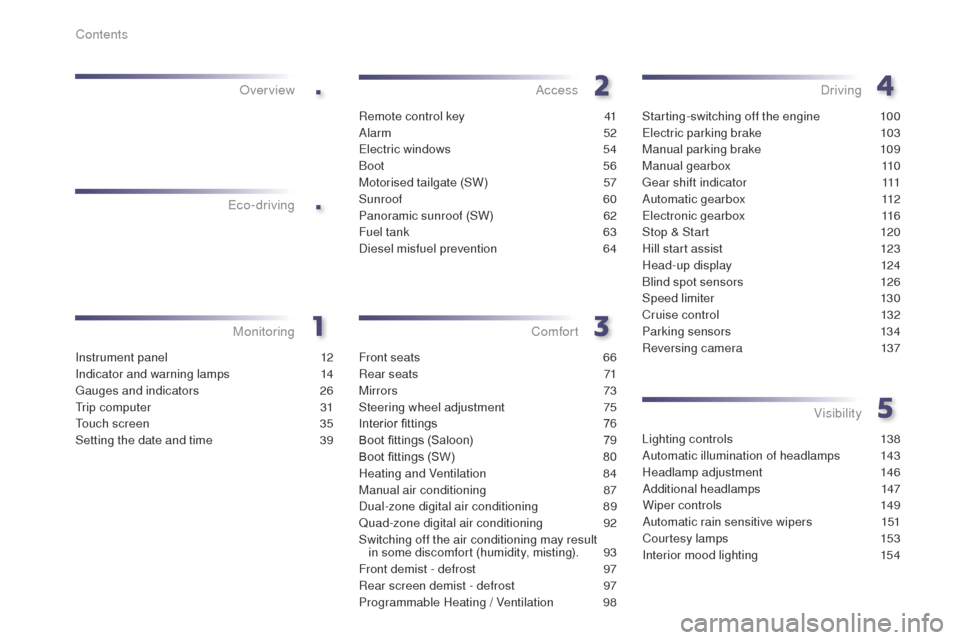
.
.
508_en_Chap00a_sommaire_ed02-2014
Instrument panel 12
Indicator and warning lamps
1
4
ga
uges and indicators
2
6
tr
ip computer
3
1
to
uch screen
3
5
Setting the date and time
3
9
MonitoringOver view
e
co-driving
Remote control key 4
1
Alarm
52
el
ectric windows
5
4
Boot
56
Motorised tailgate (SW)
5
7
Sunroof
6
0
Panoramic sunroof (SW)
6
2
Fuel tank
6
3
Diesel misfuel prevention
6
4
Access
Front seats 6 6
Rear seats
7
1
Mirrors
7
3
Steering wheel adjustment
7
5
Interior fittings
7
6
Boot fittings (Saloon)
7
9
Boot fittings (SW)
8
0
Heating and Ventilation
8
4
Manual air conditioning
8
7
Dual-zone digital air conditioning
8
9
Quad-zone digital air conditioning
9
2
Switching off the air conditioning may result in some discomfort (humidity, misting).
9
3
Front demist - defrost
9
7
Rear screen demist - defrost
9
7
Programmable Heating / Ventilation
9
8
Comfort
Starting-switching off the engine 100
el
ectric parking brake
1
03
Manual parking brake
1
09
Manual gearbox
1
10
ge
ar shift indicator
1
11
Automatic gearbox
1
12
ele
ctronic gearbox
1
16
Stop & Start
1
20
Hill start assist
1
23
Head-up display
1
24
Blind spot sensors
1
26
Speed limiter
1
30
Cruise control
1
32
Parking sensors
1
34
Reversing camera
1
37
Driving
Lighting controls 138
Automatic illumination of headlamps
1
43
Headlamp adjustment
1
46
Additional headlamps
1
47
Wiper controls
1
49
Automatic rain sensitive wipers
1
51
Courtesy lamps
1
53
Interior mood lighting
1
54
Visibility
Contents
Page 5 of 380
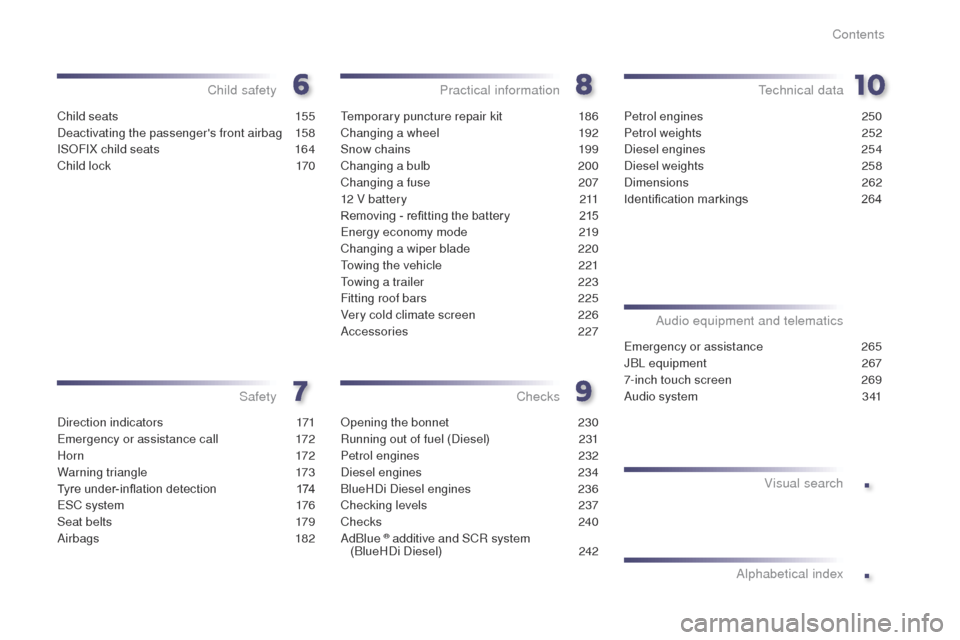
.
.
508_en_Chap00a_sommaire_ed02-2014
Child seats 155
Deactivating the passenger's front airbag
1
58
ISOFIX child seats
1
64
Child lock
1
70
Child safety
Direction indicators 1 71
em
ergency or assistance call
1
72
H o r n
172
Warning triangle
1
73
Tyre under-inflation detection
1
74
e
SC system
1
76
Seat belts
1
79
Airbags
1
82
Safety
temporary puncture repair kit 186
Changing a wheel
1
92
Snow chains
1
99
Changing a bulb
2
00
Changing a fuse
2
07
12 V battery
2
11
Removing - refitting the battery
2
15
en
ergy economy mode
2
19
Changing a wiper blade
2
20
to
wing the vehicle
2
21
to
wing a trailer
2
23
Fitting roof bars
2
25
Very cold climate screen
2
26
Accessories
227
Practical information
Opening the bonnet 2 30
Running out of fuel (Diesel)
2
31
Petrol engines
2
32
Diesel engines
2
34
BlueHDi Diesel engines
2
36
Checking levels
23
7
Checks
240
AdBlue
® additive and SCR system
(BlueHDi Diesel) 2 42
Checks
Petrol engines 2 50
Petrol weights
2
52
Diesel engines
2
54
Diesel weights
2
58
Dimensions
262
Identification markings
2
64
technical data
emergency or assistance 2 65
JBL equipment
2
67
7-inch touch screen
2
69
Audio system
3
41
Audio equipment and telematics
Alphabetical indexVisual search
Contents
Page 6 of 380
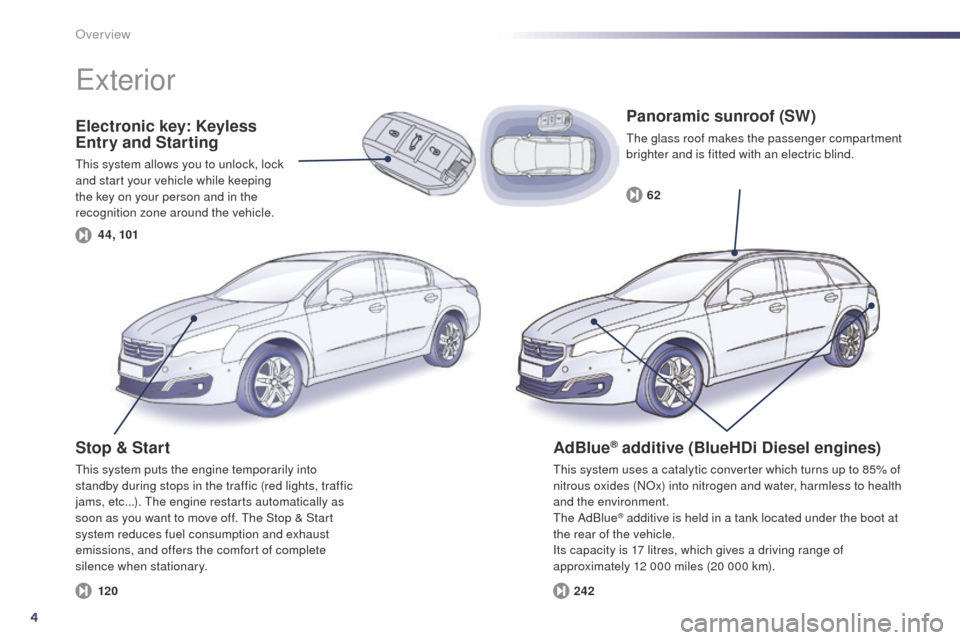
4
4 4, 10124262
120
508_en_Chap00b_vue-ensemble_ed02-2014
Over view
Electronic key: Keyless
Entry and Starting
this system allows you to unlock, lock
and start your vehicle while keeping
the key on your person and in the
recognition zone around the vehicle.
exterior
Stop & Start
this system puts the engine temporarily into
standby during stops in the traffic (red lights, traffic
jams, etc...). t
h
e engine restarts automatically as
soon as you want to move off.
t
h
e Stop & Start
system reduces fuel consumption and exhaust
emissions, and offers the comfort of complete
silence when stationary.
Panoramic sunroof (SW)
the glass roof makes the passenger compartment
brighter and is fitted with an electric blind.
AdBlue® additive (BlueHDi Diesel engines)
this system uses a catalytic converter which turns up to 85% of
nitrous oxides (NOx) into nitrogen and water, harmless to health
and the environment.
th
e AdBlue
® additive is held in a tank located under the boot at
the rear of the vehicle.
Its capacity is 17 litres, which gives a driving range of
approximately 12 000 miles (20 000 km).
Page 12 of 380
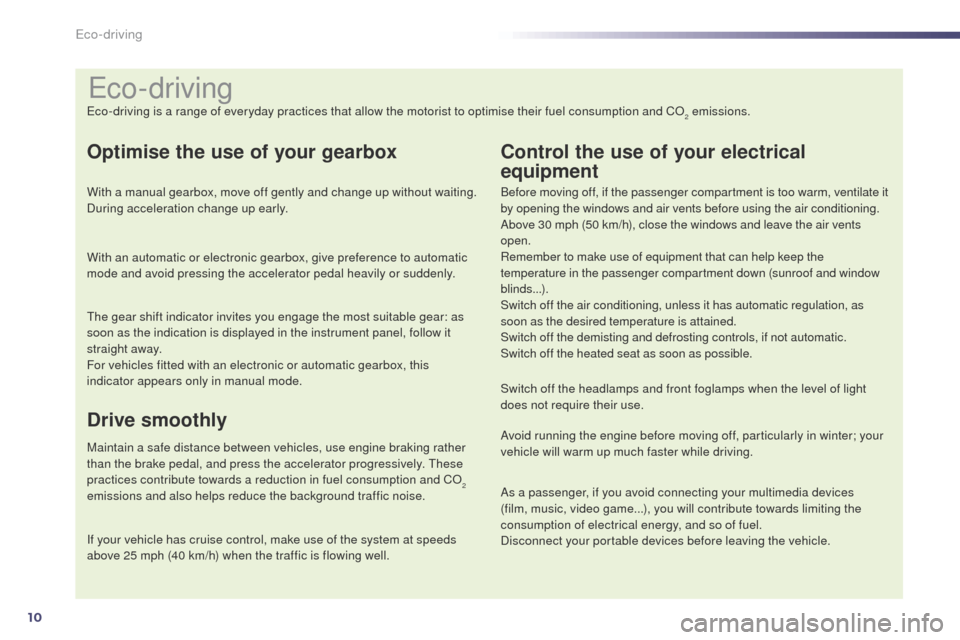
10
eco-driving
eco-driving is a range of everyday practices that allow the motorist to optimise their fuel consumption and CO2 emissions.
Optimise the use of your gearbox
With a manual gearbox, move off gently and change up without waiting.
During acceleration change up early.
With an automatic or electronic gearbox, give preference to automatic
mode and avoid pressing the accelerator pedal heavily or suddenly.
th
e gear shift indicator invites you engage the most suitable gear: as
soon as the indication is displayed in the instrument panel, follow it
straight away.
For vehicles fitted with an electronic or automatic gearbox, this
indicator appears only in manual mode.
Drive smoothly
Maintain a safe distance between vehicles, use engine braking rather
than the brake pedal, and press the accelerator progressively. th ese
practices contribute towards a reduction in fuel consumption and CO
2
emissions and also helps reduce the background traffic noise.
If your vehicle has cruise control, make use of the system at speeds
above 25 mph (40 km/h) when the traffic is flowing well.
Control the use of your electrical
equipment
Before moving off, if the passenger compartment is too warm, ventilate it
by opening the windows and air vents before using the air conditioning.
Above 30 mph (50 km/h), close the windows and leave the air vents
open.
Remember to make use of equipment that can help keep the
temperature in the passenger compartment down (sunroof and window
blinds...).
Switch off the air conditioning, unless it has automatic regulation, as
soon as the desired temperature is attained.
Switch off the demisting and defrosting controls, if not automatic.
Switch off the heated seat as soon as possible.
Switch off the headlamps and front foglamps when the level of light
does not require their use.
Avoid running the engine before moving off, particularly in winter; your
vehicle will warm up much faster while driving.
As a passenger, if you avoid connecting your multimedia devices
(film, music, video game...), you will contribute towards limiting the
consumption of electrical energy, and so of fuel.
Disconnect your portable devices before leaving the vehicle.
eco-driving
Page 13 of 380
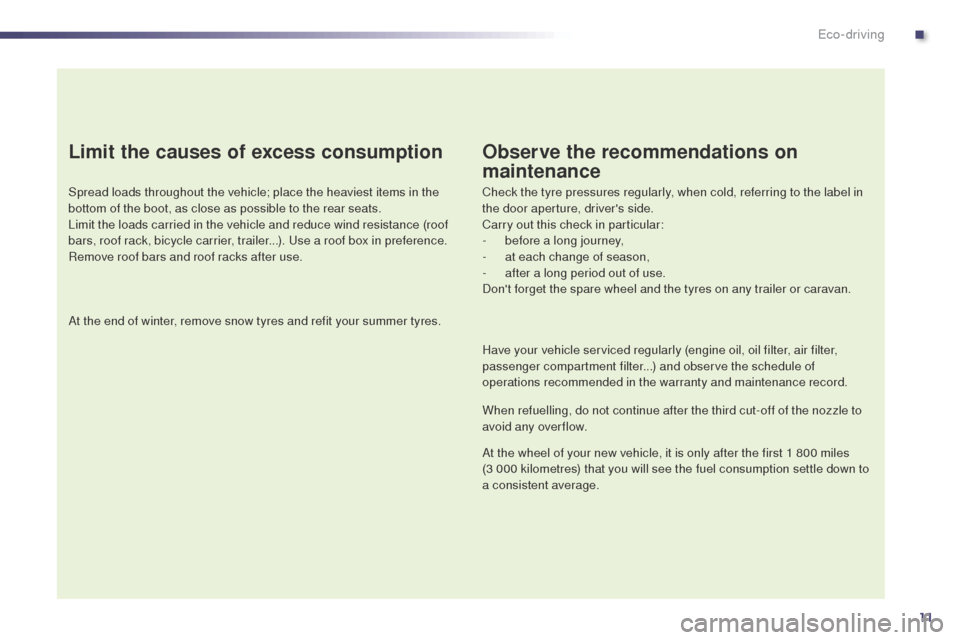
11
Limit the causes of excess consumption
Spread loads throughout the vehicle; place the heaviest items in the
bottom of the boot, as close as possible to the rear seats.
Limit the loads carried in the vehicle and reduce wind resistance (roof
bars, roof rack, bicycle carrier, trailer...). u
s
e a roof box in preference.
Remove roof bars and roof racks after use.
At the end of winter, remove snow tyres and refit your summer tyres.
Observe the recommendations on
maintenance
Check the tyre pressures regularly, when cold, referring to the label in
the door aperture, driver's side.
Carry out this check in particular:
-
b
efore a long journey,
-
a
t each change of season,
-
a
fter a long period out of use.
Don't forget the spare wheel and the tyres on any trailer or caravan.
Have your vehicle serviced regularly (engine oil, oil filter, air filter,
passenger compartment filter...) and observe the schedule of
operations recommended in the warranty and maintenance record.
When refuelling, do not continue after the third cut-off of the nozzle to
avoid any over flow.
At the wheel of your new vehicle, it is only after the first 1 800 miles
(3 000 kilometres) that you will see the fuel consumption settle down to
a consistent average.
.
Eco-driving
Page 14 of 380
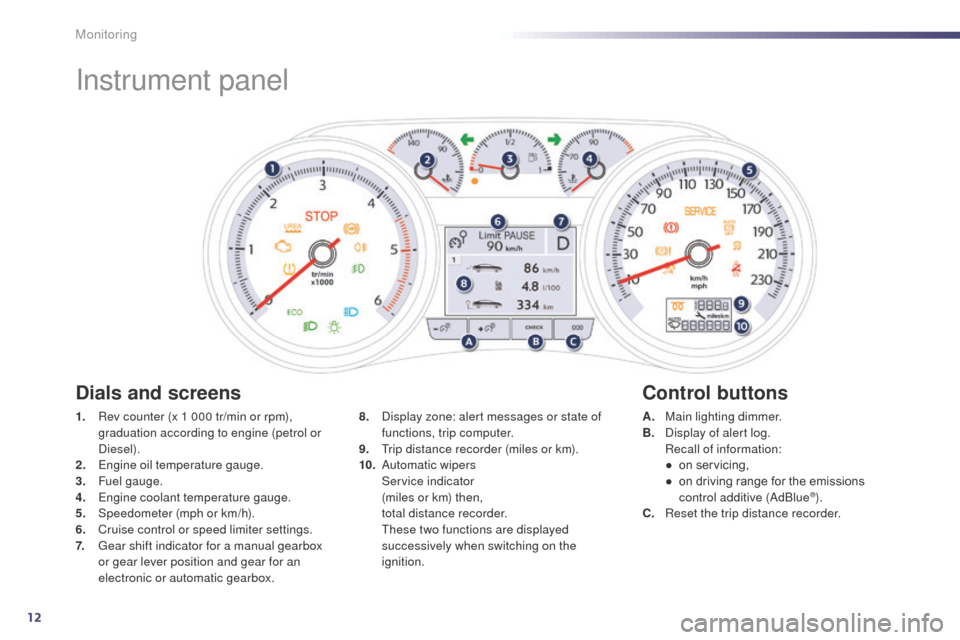
12
Monitoring
Instrument panel
1. Rev counter (x 1 000 tr/min or rpm), graduation according to engine (petrol or
Diesel).
2.
e
n
gine oil temperature gauge.
3.
F
uel gauge.
4.
e
ng
ine coolant temperature gauge.
5.
Spe
edometer (mph or km/h).
6.
C
ruise control or speed limiter settings.
7.
g
e
ar shift indicator for a manual gearbox
or gear lever position and gear for an
electronic or automatic gearbox. A. M
ain lighting dimmer.
B. D isplay of alert log.
R
ecall of information:
●
o
n servicing,
●
o
n driving range for the emissions
control additive (AdBlue
®).
C. R
eset the trip distance recorder.
8.
D
isplay zone: alert messages or state of
functions, trip computer.
9.
t
r
ip distance recorder (miles or km).
10.
Aut
omatic wipers
S
ervice indicator (
miles or km) then, t
otal distance recorder.
t
h
ese two functions are displayed
successively when switching on the
ignition.
Dials and screens Control buttons
Page 16 of 380
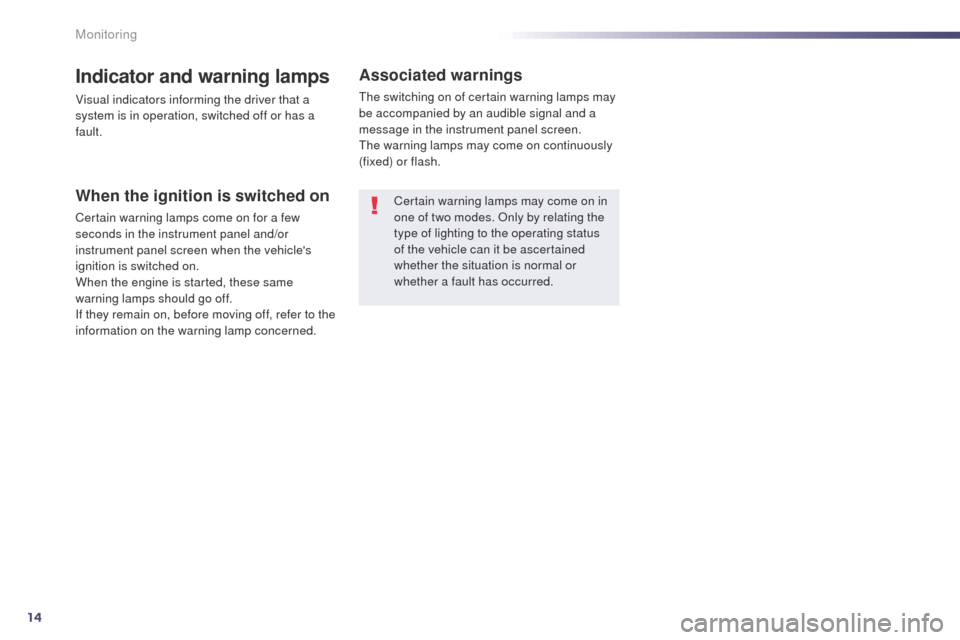
14
Indicator and warning lamps
Visual indicators informing the driver that a
system is in operation, switched off or has a
fault.
When the ignition is switched on
Certain warning lamps come on for a few
seconds in the instrument panel and/or
instrument panel screen when the vehicle's
ignition is switched on.
When the engine is started, these same
warning lamps should go off.
If they remain on, before moving off, refer to the
information on the warning lamp concerned.
Associated warnings
the switching on of certain warning lamps may
be accompanied by an audible signal and a
message in the instrument panel screen.
th
e warning lamps may come on continuously
(fixed) or flash.
Certain warning lamps may come on in
one of two modes. Only by relating the
type of lighting to the operating status
of the vehicle can it be ascertained
whether the situation is normal or
whether a fault has occurred.
Monitoring
Page 18 of 380
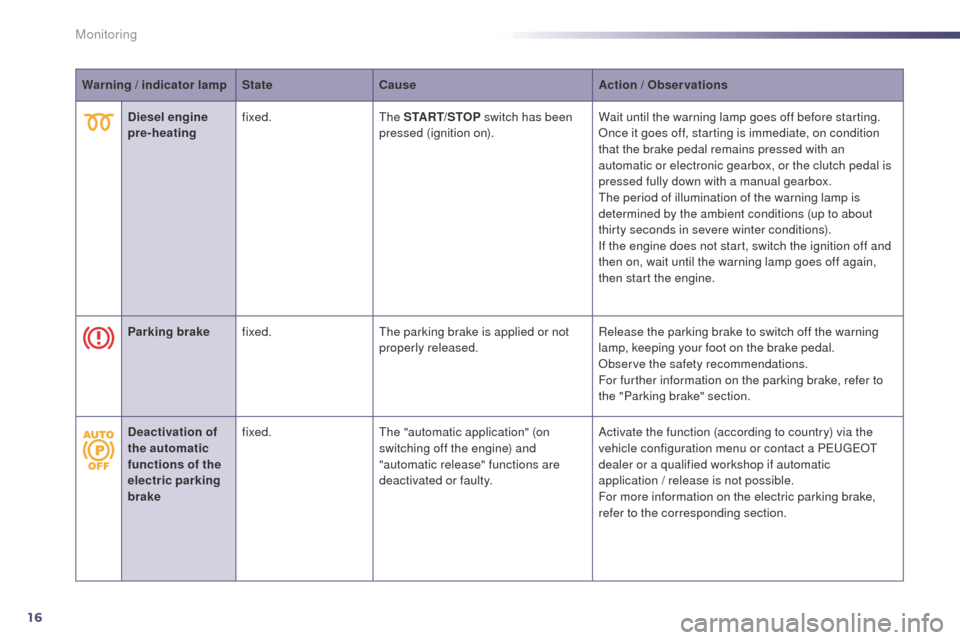
16
Warning / indicator lampStateCause Action / Observations
Diesel engine
pre-heating fixed.
th
e START/STOP switch has been
pressed (ignition on). Wait until the warning lamp goes off before starting.
Once it goes off, starting is immediate, on condition
that the brake pedal remains pressed with an
automatic or electronic gearbox, or the clutch pedal is
pressed fully down with a manual gearbox.
th
e period of illumination of the warning lamp is
determined by the ambient conditions (up to about
thirty seconds in severe winter conditions).
If the engine does not start, switch the ignition off and
then on, wait until the warning lamp goes off again,
then start the engine.
Parking brake fixed.
th
e parking brake is applied or not
properly released. Release the parking brake to switch off the warning
lamp, keeping your foot on the brake pedal.
Observe the safety recommendations.
For further information on the parking brake, refer to
the "Parking brake" section.
Deactivation of
the automatic
functions of the
electric parking
brake fixed.
th
e "automatic application" (on
switching off the engine) and
"automatic release" functions are
deactivated or faulty. Activate the function (according to country) via the
vehicle configuration menu or contact a P
e
uge
Ot
dealer or a qualified workshop if automatic
application
/ release is not possible.
For more information on the electric parking brake,
refer to the corresponding section.
Monitoring
Page 19 of 380
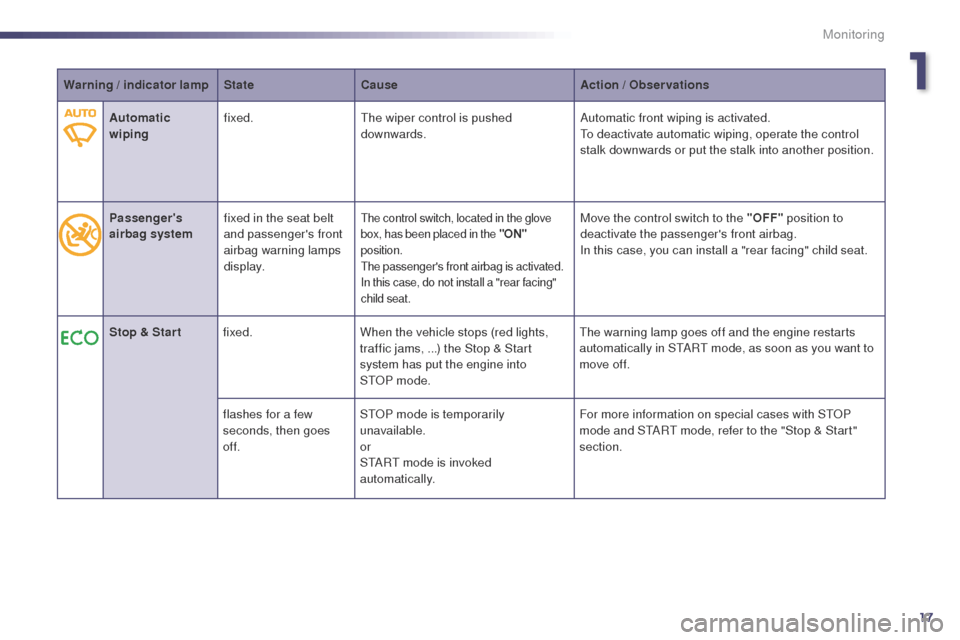
17
Warning / indicator lampStateCause Action / Observations
Automatic
wiping fixed.
th
e wiper control is pushed
downwards. Automatic front wiping is activated.
to d
eactivate automatic wiping, operate the control
stalk downwards or put the stalk into another position.
Passenger's
airbag system fixed in the seat belt
and passenger's front
airbag warning lamps
display.
the control switch, located in the glove
box, has been placed in the "ON"
position.
the
passenger's front airbag is activated.
In this case, do not install a "rear facing"
child seat.Move the control switch to the "OFF" position to
deactivate the passenger's front airbag.
In this case, you can install a "rear facing" child seat.
Stop & Star t fixed. When the vehicle stops (red lights,
traffic jams, ...) the Stop & Start
system has put the engine into
S
t
OP
mode.
th
e warning lamp goes off and the engine restarts
automatically in S
tA
R
t
mode, as soon as you want to
move off.
flashes for a few
seconds, then goes
of f. S
tO
P mode is temporarily
unavailable.
or
S
tA
R
t
mode is invoked
automatically. For more information on special cases with S
tO
P
mode and S
tA
R
t
mode, refer to the "Stop & Start"
section.
1
Monitoring
Page 21 of 380
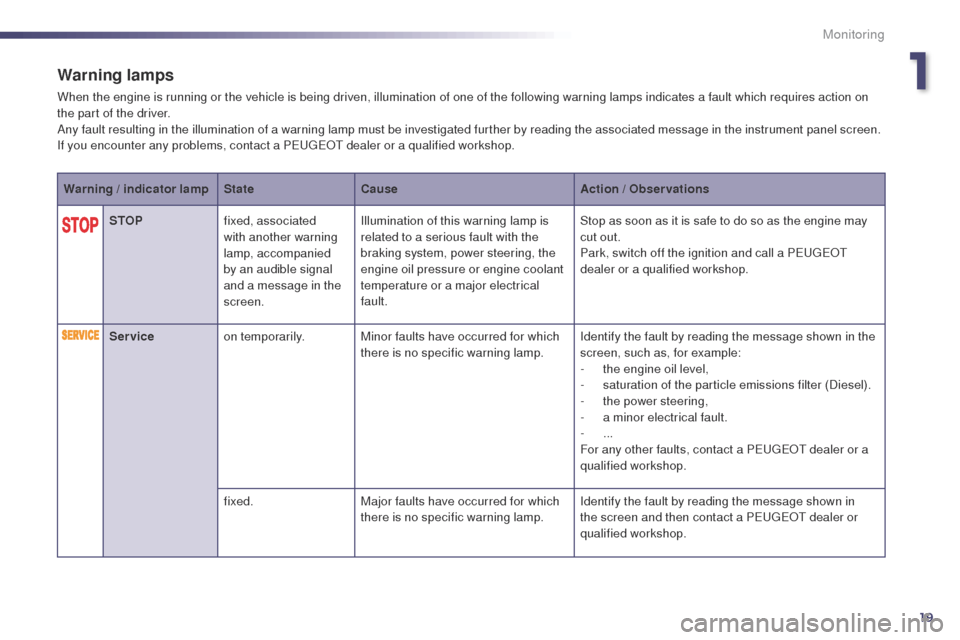
19
Warning lamps
When the engine is running or the vehicle is being driven, illumination of one of the following warning lamps indicates a fault which requires action on
the part of the driver.
Any fault resulting in the illumination of a warning lamp must be investigated further by reading the associated message in the instrument panel screen.
If you encounter any problems, contact a P
e
uge
Ot
dealer or a qualified workshop.
Warning / indicator lamp StateCause Action / Observations
STOP fixed, associated
with another warning
lamp, accompanied
by an audible signal
and a message in the
screen. Illumination of this warning lamp is
related to a serious fault with the
braking system, power steering, the
engine oil pressure or engine coolant
temperature or a major electrical
fault. Stop as soon as it is safe to do so as the engine may
cut out.
Park, switch off the ignition and call a P
e
uge
Ot
dealer or a qualified workshop.
Service on temporarily. Minor faults have occurred for which
there is no specific warning lamp. Identify the fault by reading the message shown in the
screen, such as, for example:
-
t
he engine oil level,
-
s
aturation of the particle emissions filter (Diesel).
-
t
he power steering,
-
a m
inor electrical fault.
-
...
For any other faults, contact a P
e
uge
Ot
dealer or a
qualified workshop.
fixed. Major faults have occurred for which
there is no specific warning lamp. Identify the fault by reading the message shown in
the screen and then contact a P
e
uge
Ot
dealer or
qualified workshop.
1
Monitoring